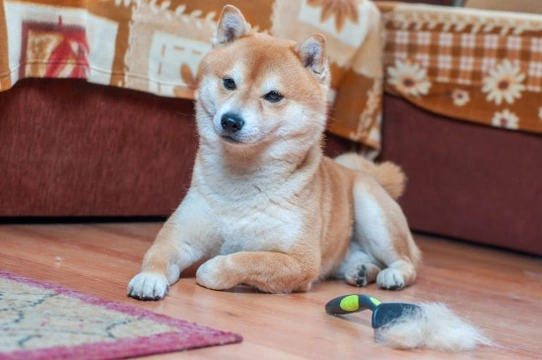
Grooming a heavy-shedding dog and dealing with a blown coat
Certain dog breeds need very little coat maintenance, due to having short, straight and single-layered fur that largely takes care of itself. However, if your dog is the exact opposite of this, being longhaired, double coated or a really heavy shedder, you probably find yourself waging a constant battle with a hoover and a grooming kit to keep the clouds of shed hair under control.
Added to this, some breeds, whether they shed heavily year-round or not go through a seasonal process known as “blowing their coat.” This term refers to a process that happens twice or three times a year when the dog will shed their entire coat over the course of two to three weeks, brining in an entirely new coat for the new season. During the time when the dog is blowing their coat, they will shed copious quantities of fur all over the place, and you will likely not even be able to pat your dog without creating a cloud of fur!
If your dog is a heavy shedder like the Golden Retriever, or is one of the breeds such as the Akita or the Siberian Husky that blow their coat regularly, read on for some tips on how to groom them and keep things under control as much as possible.
Grooming tools
As well as of course an industrial-strength hoover to deal with the fur you are apt to find all over the house, you should keep a special grooming kit of tools that are specially designed to deal with your dog’s own coat, that can cope with the demands of thick fur, two layers, and lots of fluff!
Invest in at least two different combs of different densities, a plastic curry comb, an undercoat rake, a slicker brush, a shedding blade, and various other brushes of different types that can get right through your dog’s fur.
Basic grooming routine
If your dog is a heavy shedder, you will likely need to groom them several times a week, or even on a daily basis when they are blowing their coat. This might seem like rather a chore, but it comes with the territory of owning a hairy dog, and if you start to slack, you will just build up problems for yourself further down the line!
Begin with the plastic curry comb, and use this to comb through the top layer of hair and bring any dirt and debris to the surface. Then, use the undercoat rake following the lie of the hair, to bring up shed areas of the undercoat that have become trapped in the top coat. Your slicker brush can then be used to remove these hairs from the coat itself.
Finally, use the shedding blade to thin and remove the excess fur from both layers of the coat, comb through any knots, and give your dog’s surface hair a brush over to make it lie straight.
Bathing your dog
Heavy shedding dogs or dogs that are coming towards the end of their coat blow can benefit from bathing to stimulate the skin and remove the final lot of shed hairs. Prior to bathing, spend as long as you need to brushing and combing the coat to remove as much shed hair as you can. Whether you put your dog in the bath or shower or set them up with a tub outside, make sure that the drain hole that the runoff water will go down is able to handle the quantity of shed fur that will wash off with the water!
Use a mild baby shampoo or gentle dog shampoo on your dog, and begin at the shoulder, washing the back and downwards to the limbs, brushing or combing out shed hair as you go. Tackle the face last, and do this with extreme care, to avoid getting shampoo in your dog’s eyes.
The most important part of bathing any dog is ensuring that the soapy water is thoroughly washed off them, and no shampoo is left on the skin or in the coat, as this can cause irritation. Pay close attention to rinsing off your dog along every part of their body, and do not call it a day until the water runs clear.
You can the towel dry your dog, blow dry them, or let them dry naturally if it is warm outside or you have the radiators on.
Tips for managing shed fur within the home
When your dog is blowing their coat, it can be helpful to restrict them from certain areas of the home, to make the clearing up process less daunting. Particularly try to avoid rooms with carpet and lots of soft furnishings, as it is much harder to get hair out of fabric than off hard surfaces!
Regular grooming will help to keep hair to a minimum, as will regular hoovering, as shed hair will soon become woven into the weft of all types of fabrics.



